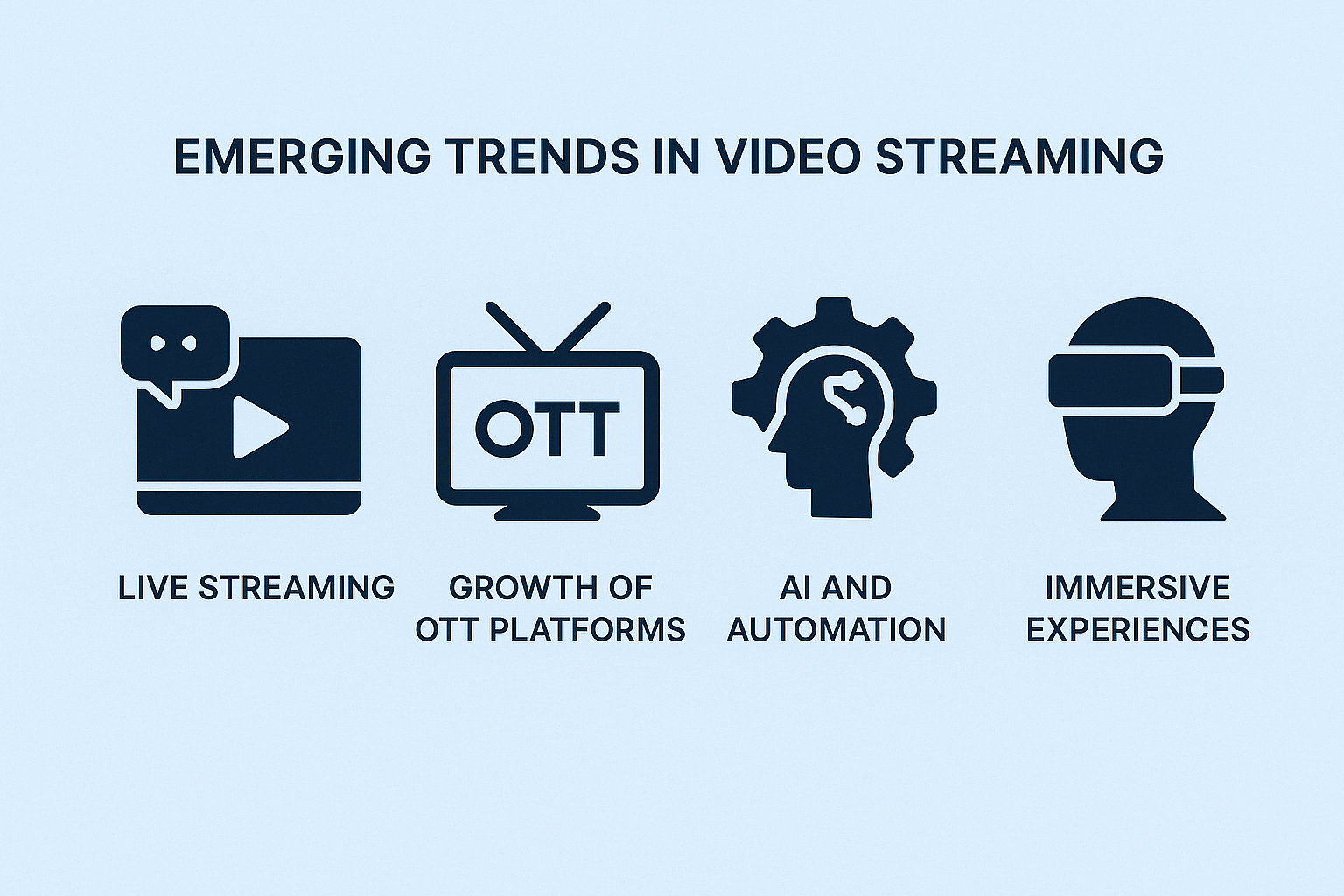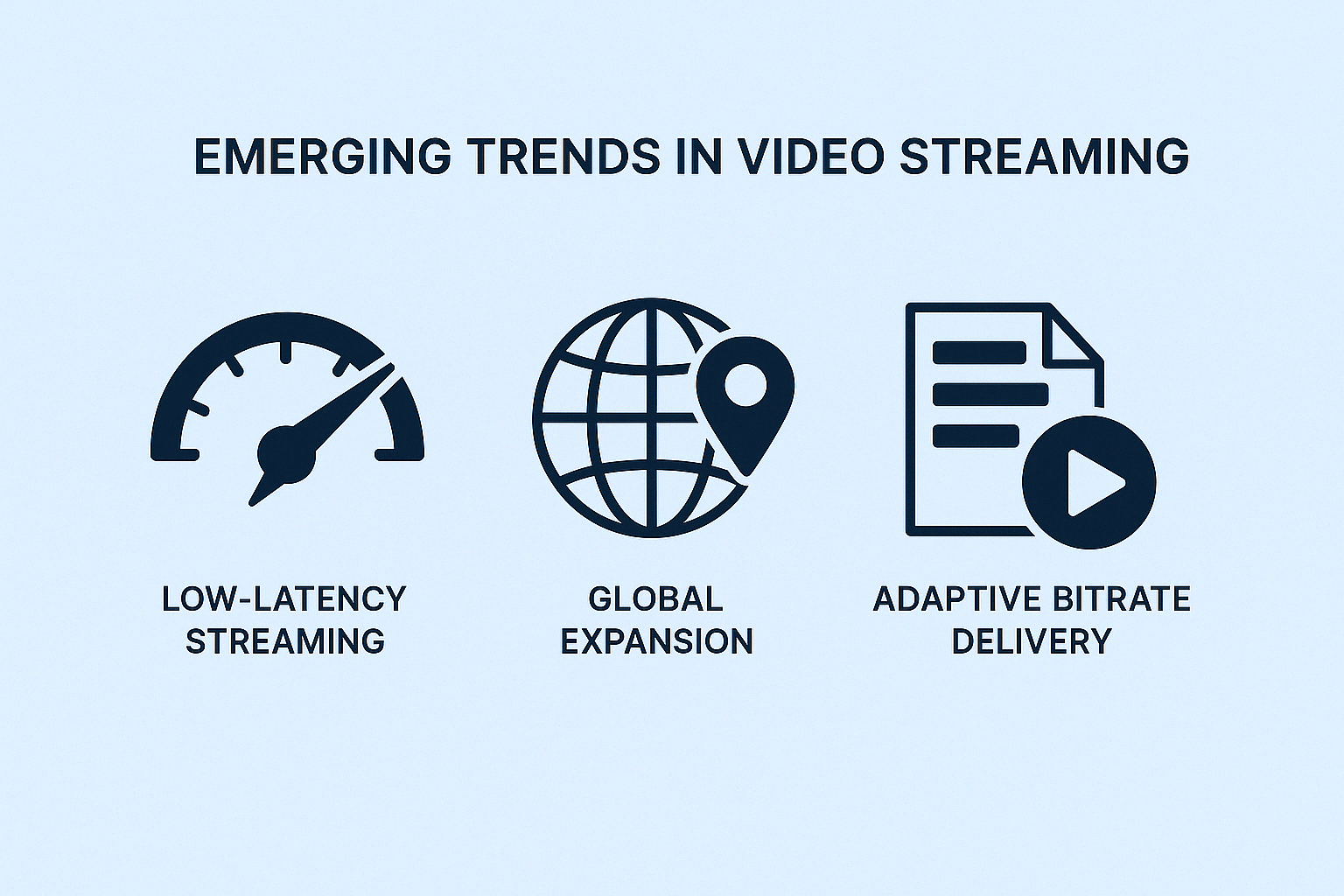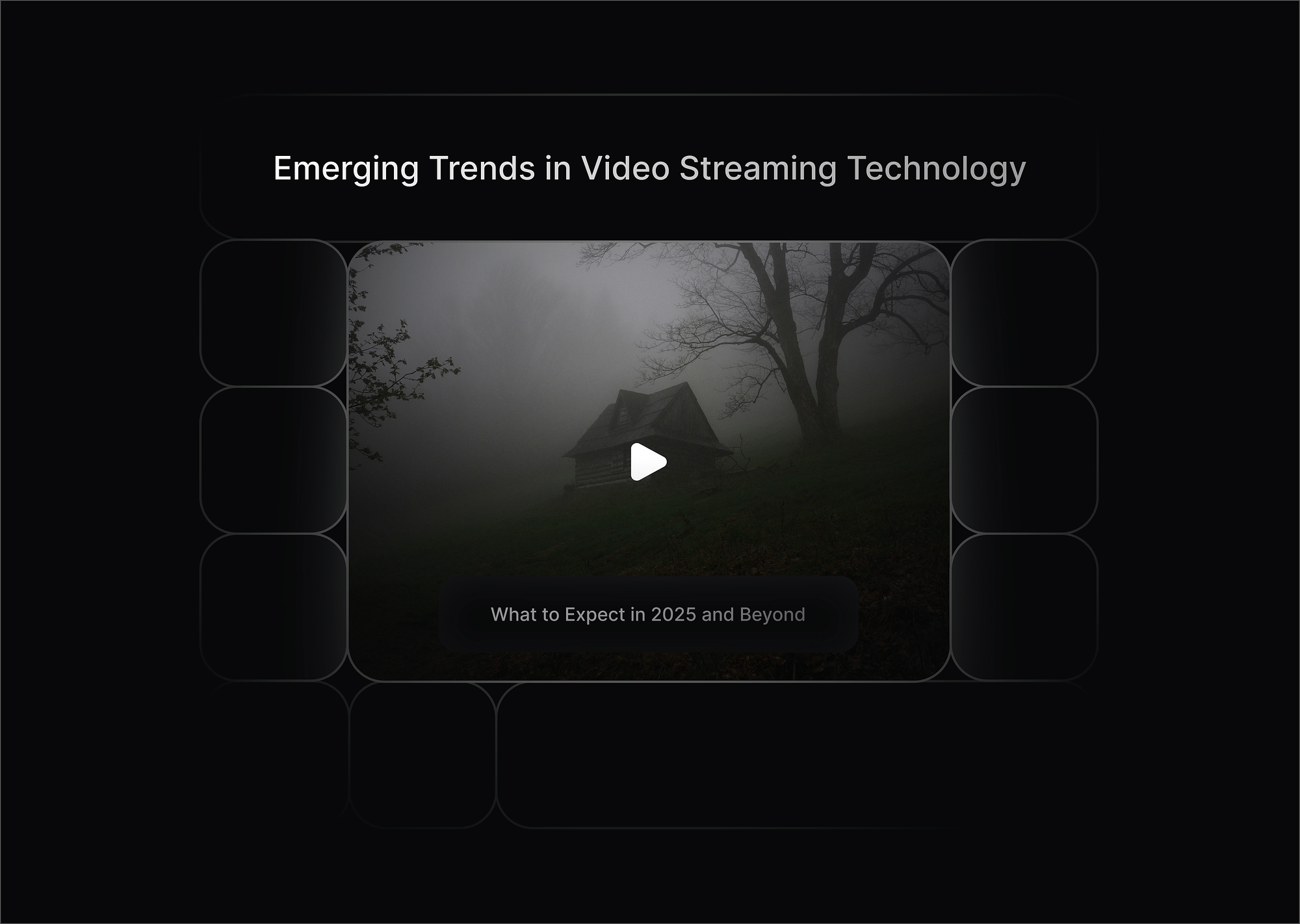From binge-worthy OTT platforms to real-time live interactions and immersive VR experiences; video streaming has transformed how we consume content. As we approach 2025, the streaming landscape continues to evolve at lightning speed, driven by rapid tech advancements, shifting viewer behavior, and smarter content delivery methods.
This guide explores the emerging video streaming trends you need to know; whether you're a content creator, media company, or tech enthusiast. From AI-enhanced personalization to ultra-low latency streaming, we’ll break down the biggest innovations shaping the future of digital video. In this blog we draw on insights from Gumlet’s experience powering video infrastructure for thousands of global publishers, creators, and platforms.
The Growth of Live Streaming
Live streaming has exploded in popularity, transitioning from niche gaming sessions to mainstream entertainment, education, e-commerce, and brand engagement. In 2025, it’s not just about going live, it’s about creating real-time, interactive experiences that build communities and drive results.
Real-Time Engagement Takes Center Stage
Modern audiences crave interaction. Features like live Q&A, real-time polls, emoji reactions, and chat overlays are redefining how content is consumed, and participated in. Platforms like YouTube Live, Twitch, and Instagram Live have embraced this shift, making broadcasts feel less like one-way transmissions and more like shared experiences.
E-commerce Meets Live Streaming
Live commerce is booming in regions like China and steadily catching on globally. Brands now host live product demos, flash sales, and influencer showcases; directly converting viewers into buyers in real-time. According to Exploding Topics, this blend of entertainment and retail is expected to grow substantially by 2025.
Platform Powerhouses
- Twitch: Still the leader in gaming, Twitch is expanding into music, talk shows, and even fitness.
- YouTube Live: Increasingly adopted for events, product launches, and education.
- Facebook Live: A go-to for influencers, small businesses, and community pages.
Live streaming isn’t just a feature anymore; it’s a core part of modern media strategy.
The Rise of OTT Streaming Platforms
The dominance of Over-the-Top (OTT) platforms has rewritten the rules of video consumption. With users ditching traditional cable TV, OTT continues to set the gold standard for on-demand, anywhere-anytime viewing.
Subscription Models Are Evolving
From Netflix and Disney+ to HBO Max and Amazon Prime Video, the SVOD (Subscription Video on Demand) model has become the norm. Yet in 2025, we're seeing a rising wave of AVOD (Ad-Supported Video on Demand) services, offering free or freemium access in exchange for targeted ads. Think Tubi, Pluto TV, and Freevee.
Fragmentation and Niche Platforms
With more players entering the market, audiences are now juggling multiple subscriptions. This has led to content fragmentation, with niche OTT platforms carving out loyal followings. Whether it’s anime (Crunchyroll), documentaries (Curiosity Stream), or regional cinema, micro-niche content is becoming more discoverable and profitable.
Mobile-First Streaming
OTT platforms are optimizing aggressively for mobile users, especially in emerging markets. With increasing access to 5G networks and affordable smartphones, mobile-first consumption now drives platform design, video resolution choices, and content length.
AI in Video Streaming: Revolutionizing Content Delivery
Artificial Intelligence (AI) is no longer optional in video streaming, it’s essential. From recommendation engines to content optimization, AI streaming services are shaping the viewer experience at every level.
Personalized Content Recommendations
Netflix set the bar for algorithm-driven recommendations, and now every major streaming service has followed suit. AI leverages watch history, engagement patterns, device data, and even sentiment analysis to predict what a user might enjoy next; keeping viewers hooked and reducing churn.
Automated Video Enhancements
AI is also streamlining production workflows. Today, platforms like Gumlet and Muvi use AI to:
- Auto-generate subtitles in 125+ languages
- Tag and categorize content
- Detect scenes and highlights for smarter previews
- Many modern video platforms now offer powerful video APIs that allow developers to automate workflows, from content tagging to video publishing.
These tools not only boost accessibility but also improve searchability and content discoverability across platforms.
AI-Powered Personalization Beyond Content
AI goes beyond recommendations; it’s also adapting bitrate, thumbnail generation, and even video length based on individual user preferences. With predictive analytics and real-time adjustments, streaming becomes not just smart, but predictive and anticipatory.
Immersive Video Experiences: VR and AR Streaming
Virtual Reality (VR) and Augmented Reality (AR) are no longer experimental technologies; they are becoming core components of the immersive media future.
VR in Sports and Live Events
Want front-row seats to a concert in London while sitting at home in LA? VR makes it possible. Platforms like NextVR and Meta Horizon Worlds are turning live events into immersive, 360° experiences that enhance audience engagement.
VR Gaming and Streaming Platforms
Video game streaming platforms like Twitch and YouTube Gaming are incorporating VR and AR overlays, offering viewers a more immersive connection with streamers. VR games are also gaining traction, especially with devices like Oculus Quest and Sony PSVR2 pushing higher-quality content.
Future Potential of Immersive Content
As cloud rendering and 5G streaming mature, expect a new wave of interactive VR content from virtual classrooms and simulated travel to metaverse-style shared experiences. For brands, this opens doors to deeper engagement and storytelling formats.

Low Latency Streaming: The Need for Instant Playback
In the age of real-time engagement, low latency is no longer a luxury, it’s a necessity.
Why Low Latency Matters
Latency means the delay between when a video is captured and when it appears on screen. This aspect of video streaming can make or break real-time experiences. High latency leads to desynchronized interactions, buffering, and missed opportunities for engagement.
For scenarios like Live sports, Auction platforms, E-learning with Q&A, Live commerce and gaming a delay of even a few seconds can affect both user experience and outcomes.
Applications in Gaming, Sports, and Events
- Esports and online tournaments rely on instant reaction and zero lag.
- Interactive webinars require live feedback to feel engaging.
- Stock market streams and betting platforms demand real-time accuracy.
The Role of 5G and Edge Networks
With the global rollout of 5G, ultra-low latency streaming is becoming a reality. Coupled with Edge CDN technology, streaming platforms can now reduce delay to sub-second latency, enhancing responsiveness and opening the door to interactive video applications.
The Evolution of Video Monetization
Monetizing video content has become more dynamic than ever. As consumption patterns evolve, so do the methods by which platforms and creators turn engagement into revenue.
AVOD and SVOD: The Two Giants
The two dominant models: Ad-supported Video on Demand (AVOD) and Subscription Video on Demand (SVOD) continue to thrive but serve different audience segments.
- SVOD platforms (like Netflix, Hulu, Disney+) offer ad-free viewing for a monthly fee.
- AVOD services (like Tubi, Pluto TV) attract users with free content monetized through ads.
In 2025, we’re seeing a hybrid approach, where even premium platforms are introducing lower-cost, ad-supported tiers to broaden reach without diluting revenue.
Micro-transactions & Pay-Per-View
The growing demand for exclusive, limited-access content has driven the adoption of pay-per-view and micro-transaction models, especially for:
- Live sports and concerts
- Online courses and workshops
- One-time access to premium series or indie films
Platforms are also integrating digital wallets and tokens, paving the way for blockchain-based monetization in the near future.
Empowering Independent Creators
With platforms like Gumlet, Patreon, and Vimeo OTT, content creators now have complete control over how they monetize their work. From selling access to gated video collections to embedding CTAs and donation buttons, creators can diversify revenue beyond traditional ads.
Adaptive Bitrate Streaming: Enhancing Video Quality Across Devices
Viewers stream from every kind of device and network — from high-speed fiber connections on 4K TVs to mobile data on low-end smartphones. This variability makes Adaptive Bitrate Streaming (ABR) a critical piece of modern video delivery.
Seamless Experience Across All Network Conditions
ABR works by dynamically adjusting the video resolution based on the user’s current bandwidth. If the network is strong, the video plays in high definition. If it drops, the stream continues in a lower resolution to avoid buffering.
This ensures:
- Minimal interruption
- Faster load times
- Better user retention
The Role of CDNs in Optimization
Video CDN (Content Delivery Networks) like Cloudflare, AWS CloudFront, and Gumlet’s optimized delivery layer help distribute video content across edge servers worldwide. Combined with ABR, CDNs ensure lightning-fast delivery while reducing load on origin servers. APIs also play a critical role in configuring playback settings, managing adaptive bitrate profiles, and integrating analytics into custom video workflows.
In 2025, ABR + edge computing will be essential to delivering consistent, high-quality video experiences globally.

What to Expect from Video Streaming in 2025 and Beyond
The video streaming industry is not slowing down — it’s gearing up for its most innovative decade yet. As a company working at the intersection of media delivery and technology, Gumlet tracks emerging streaming trends closely to guide product development and client strategy.
The Impact of 5G, AI, and Blockchain
- 5G is enabling ultra-low latency and higher throughput, which benefits live and interactive content.
- AI will continue evolving to power hyper-personalized content, predictive engagement strategies, and smarter streaming analytics.
- Blockchain is emerging for secure licensing, micropayments, and content authenticity verification, especially in decentralized content ecosystems.
The Immersive Revolution
Expect more VR and AR integration not just in entertainment, but also in:
- Remote workspaces
- Education
- Healthcare streaming
- Virtual conferences and exhibitions
This shift toward interactive video will lead to a deeper merger of tech, storytelling, and user control.
Global Expansion and Language Localization
As streaming expands into non-English speaking markets, AI-powered subtitles, voiceovers, and regional content production will take center stage. Platforms that embrace multilingual delivery will be better positioned to win in the global race.
Conclusion
The video streaming industry is evolving faster than ever, shaped by cutting-edge technology and changing viewer behavior.
Key Takeaways:
- Live streaming is getting more interactive and central to brand and creator strategies.
- OTT platforms are branching into hybrid monetization and mobile-first content.
- AI and ABR are powering personalized, smooth experiences across devices.
- VR/AR and 5G are unlocking new immersive formats.
- The future of streaming is interactive, global, intelligent, and decentralized.
Whether you're a business, a creator, or just a content enthusiast, staying ahead of these trends can help you capitalize on the next wave of streaming innovation.
FAQs
What is the future of video streaming in 2025?
Video streaming in 2025 will be more personalized, immersive, and interactive. Technologies like AI, 5G, and blockchain will power smarter content delivery, while VR and AR will enhance how users experience live events and on-demand content. Our team collaborates with media brands, e-learning platforms, OTT services, and tech companies to help them scale video delivery with performance and precision.
How will AI change video streaming?
AI improves video streaming by optimizing content recommendations, automating subtitles and tagging, and delivering personalized viewing experiences. It also powers real-time analytics and adaptive delivery for improved engagement.
What is low-latency streaming?
Low-latency streaming minimizes the delay between recording and playback, often down to 1-2 seconds. It’s critical for real-time events like gaming, auctions, live sports, and webinars where interaction matters.
Why is adaptive bitrate streaming important?
Adaptive bitrate streaming ensures smooth video playback by adjusting quality based on the viewer’s internet speed. It reduces buffering, enhances accessibility, and supports streaming on any device.
How does VR and AR impact streaming?
VR and AR transform traditional video into immersive experiences, offering 360° views, interactive environments, and virtual presence in events or games. This trend is gaining ground in entertainment, education, and live sports.
What are the fastest growing streaming platforms?
Platforms like Tubi, Peacock, YouTube Live, and Twitch are seeing rapid growth, especially among younger audiences and niche content communities. Additionally, mobile-first regional platforms are expanding in emerging markets.
What is the current trend in the demand and supply of streaming services?
There’s a growing demand for personalized, ad-supported, and mobile-first content, while supply is diversifying through niche platforms, regional content creation, and hybrid monetization strategies. The result: more choices, but also more fragmentation.

